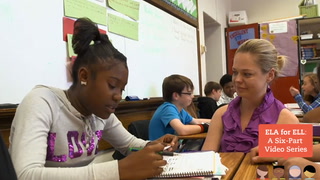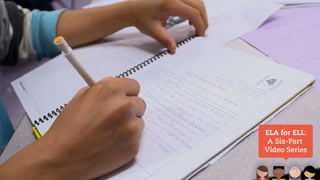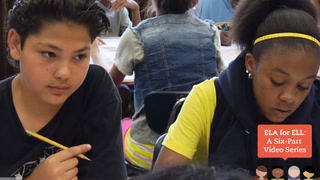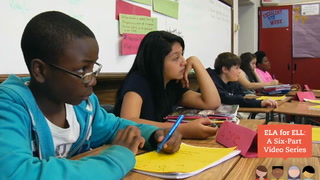Series ELA for ELL: Scaffolding Understanding for Complex Text: Preparing Learners: Activating Prior Knowledge
ELA.SL.7.1c
| Common core State Standards
- ELA: English Language Arts
- SL: Speaking and Listening Standards 6-12
- 7: 7th Grade
-
1c:
Engage effectively in a range of collaborative
discussions (one-on-one, in groups, and teacherled)
with diverse partners on grade 7 topics,
texts, and issues, building on othersâ\x80\x99 ideas and
expressing their own clearly.
a. Come to discussions prepared, having read
or researched material under study; explicitly
draw on that preparation by referring to
evidence on the topic, text, or issue to probe
and reflect on ideas under discussion.
b. Follow rules for collegial discussions, track
progress toward specific goals and deadlines,
and define individual roles as needed.
c. Pose questions that elicit elaboration and
respond to others' questions and comments
with relevant observations and ideas that bring
the discussion back on topic as needed.
d. Acknowledge new information expressed by
others and, when warranted, modify their own
views.
ELA.SL.8.1c
Common core State Standards
- ELA: English Language Arts
- SL: Speaking and Listening Standards 6-12
- 8: 8th Grade
-
1c:
Engage effectively in a range of collaborative
discussions (one-on-one, in groups, and teacherled)
with diverse partners on grade 8 topics,
texts, and issues, building on othersâ\x80\x99 ideas and
expressing their own clearly.
a. Come to discussions prepared, having read
or researched material under study; explicitly
draw on that preparation by referring to
evidence on the topic, text, or issue to probe
and reflect on ideas under discussion.
b. Follow rules for collegial discussions and
decision-making, track progress toward
specific goals and deadlines, and define
individual roles as needed.
c. Pose questions that connect the ideas of
several speakers and respond to others'
questions and comments with relevant
evidence, observations, and ideas.
d. Acknowledge new information expressed
by others, and, when warranted, qualify or
justify their own views in light of the evidence
presented.
Save to My Resources
PLEASE CREATE A NEW ACCOUNT OR LOG IN TO ACCESS THIS CONTENT
Enjoy your first video for free. Subscribe for unlimited access.
Have questions about subscribing?
Click Here to learn more about individual subscriptions.
Click Here to learn more about School and Institution access.
Discussion and Supporting Materials
Thought starters
- This lesson asks students to utilize various forms of "communicative functions" through the three-step interview. Why is this important for ELLs?
- How does the structure of this task ensure that all students are engaged in the work?
- How did Ms. Park-Friend activate her students' prior knowledge?
In Partnership With:

School Details
Bruce Randolph School3955 Steele Street
Denver CO 80205
Population: 760
Data Provided By:

Teachers
Emily Park-Friend
Newest
|
4 MIN
|
5 MIN
|
5 MIN
UNCUT CLASSROOMS
| TCHERS' VOICE
English Language Arts















143 Comments
Emelida Carrias Oct 25, 2023 11:06pm
1. Communication is important because it helps the students interact and start to familiarize and learn to coomuncate better and understand each other slowly but surely.
2. Its structured in a way that the students engage into the topic and learn more.
3. The teacher made the students recall information that they had learnt before, and they were responsible to retell the story.
Michael Daigre Sep 9, 2023 8:03pm
Communicative functions are important for English because it uses several concepts needed to communicate effectively. Including: listening, speaking and comprehension. Especially since most of these students have English as their second language, new vocabulary and sentence structure lessons are also included in communicative functions. The structure used for the interview assisgnment has a position for each group member, thus engaging each student to participate in different areas.
The teacher activated the students prior knowledge by explaining each group members task before starting. This time also allowed for questions before starting the interviews.
Gregory Broussard Jul 31, 2023 9:30pm
1. Communicative functions are important because it helps the students interactions in learning English. The interaction starts with a question or information to be shared. The interviewer has to listen to and understand the answer in determining the person being interviewed is responding to the question. If the person being interviewed does not answer the question, then the interviewer can repeat the question. The last part is the interviewer sharing with the group what he/she learned from the interviewee. This step allows the interviewee to confirm what was said, or explain. It keeps both the interviewer and interviewee engaged. Comprehension is essential for the students.
2. The structure of the task requiring the interviewer to explain the interviewees answers determines the quality of the interaction. The questions must be clearly communicated to the interviewee and understood by the interviewee, responses must be clearly communicated to the interviewer and understood by the interviewer, and the final explanation gives both participant to opportunity to confirm they understand each other. If the person being interviewed was allowed to explain his/her answers, then it would not assess if the interviewer and interviewee had a successful communication.
3. She makes the learning personal by asking students to recall the most memorable argument they have had with someone, were they either failed or succeeded in convincing the other person.
Crystal Kelley Jul 29, 2023 11:00am
1. Utilizing various forms of communicative functions is important for ELLs because they are working on reading, writing, and speaking English as a second language. This gives them the opportunity to flex all of those muscles and continue to practice those skills.
2. All students are engaged in the work because each has a partner that they will interview, who will then interview them. They'll be responsible for both speaking, listening, and recording answers. Everyone has a part.
3. Ms. Park-Friend activated her student's prior knowledge by having them recall a firsthand experience from their past. This helps make the concept of persuasion more personal and real.
DeAnna Granger Jul 4, 2023 12:10pm
1. It is important to utilize various forms of communicative functions for ELLs to ensure that the students have multiple ways to communicate their responses for their interview as well as to conduct the interview.
2. The structure of the task ensures all students are engaged in the work by the students having to interview each other.
3. The teacher had the students share a time when they were persuaded and tied that in to what was being taught.